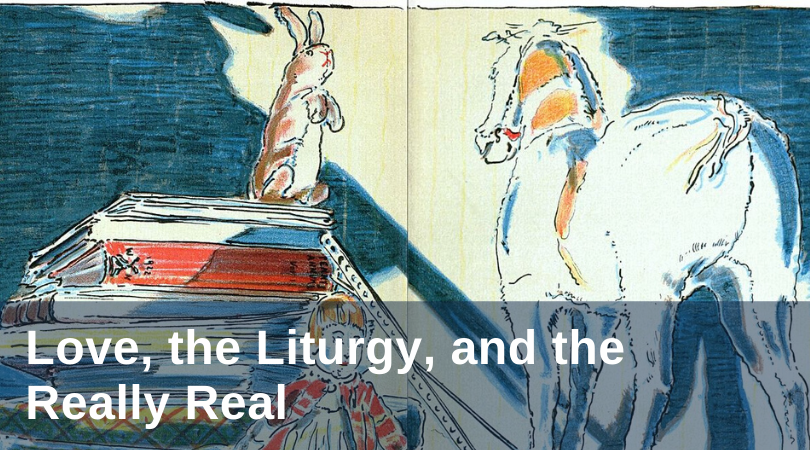
Editorial Note: This post is an excerpt from a presentation entitled “What’s Really Real? On Catholic Education and the Eucharist” presented by the author to Catholic school teachers of the Diocese of Fort Wayne–South Bend.
Liturgical theology confesses that creation is still in motion. Creation is not a past event, it is a present and on-going event. Each moment comes from God’s hand. Don’t say “God created;” say “God is creating.” He does so, as Gaudium et Spes said, with stability, proper laws, and order, making his creation susceptible to investigation. History unfolds within this stable order, and history is made of personal encounters. We have them with each other; and salvation history witnesses to personal visitations by God, as well. A liturgical view of the world sees a personal will behind all things, and that means all things are in process, because relationships grow as the one discloses himself more completely to the other.
Man and woman are still on their way to perfection, and in the liturgical vision of reality we have yet to become as real as we will be. At least, so says a fine book on metaphysics and ontology entitled The Velveteen Rabbit.
The Skin Horse had lived longer in the nursery than any of the others. He was so old that his brown coat was bald in patches and showed the seams underneath, and most of the hairs in his tail had been pulled out to string bead necklaces. He was very wise, for he had seen a long succession of mechanical toys arrive to boast and swagger, and by-and-by break their mainsprings and pass away, and he knew that they were only toys, and would never turn into anything else. For nursery magic is very strange and wonderful, and only those playthings that are old and wise and experienced, like the Skin Horse, understand all about it.
One day the newest citizen of the nursery questions the Skin Horse on ontological matters.
“What is real?” asked the Rabbit one day. “Does it mean having things that buzz inside you and a stick-out handle?”
“Real isn’t how you are made,” said the Skin Horse. “It’s a thing that happens to you. When a child loves you for a long, long time, not just to play with, but really loves you, then you become Real.”
“Does it hurt?” asked the Rabbit.
“Sometimes,” said the Skin Horse, for he was always truthful. “When you are real you don’t mind being hurt.”
“Does it happen all at once, like being wound up,” he asked, “or bit by bit?”
“It doesn’t happen all at once,” said the Skin Horse. “You become. It takes a long time. That’s why it doesn’t often happen to people who break easily, or have sharp edges, or who have to be carefully kept. Generally, by the time you are Real, most of your hair has been loved off, and your eyes drop out and you get loose in the joints and very shabby. But these things don’t matter at all, because once you are Real you can’t be ugly, except to people who don’t understand.”
“I suppose you are real?” said the Rabbit.
“The Boy’s Uncle made me Real,” he said. “That was a great many years ago; but once you are Real you can’t be made unreal again. It lasts for always.”
To see the really real—what something is, and not just what it is made of—we must be made new ourselves. Most of our hair will be loved off so we can discard the garments of skin Adam and Eve wore after the fall and can be reclothed in the glory of God. Our eyes must drop out so that we can see with new eyes. We must get loose in the joints, and not be stiff-necked like Pharaoh of old, so that we can bow our heads in submission to God. But if the ashes and crosses and fasting makes us look shabby, it doesn’t make us ugly, “except to people who don’t understand.” This is the perfection of our Baptism, when biological birth was refreshed with spiritual birth. God took what was real and made it really real.
Asceticism is a discipline or training that is begun in the waters of the font, and continues as we are being conformed to Christ to be an image of the image of God. Liturgical asceticism is Baptism stretching forward to completion. Liturgical asceticism increases the measure by which we can participate in the liturgical life to which Baptism initiated us. Liturgy is where the Kingdom is symbolized in its fullest capacity, and askesis enlarges the eyes of the perceiver; it cleanses the surface of the liturgist to reflect glory. . . .
The Catechism says [that] “liturgy is an ‘action’ of the whole Christ (Christus totus). Those who even now celebrate it without signs are already in the heavenly liturgy, where celebration is wholly communion and feast” [§1136]. The book of Revelation pictures the heavenly liturgy with the three persons of the Trinity present around a throne. God is seated upon it, the Lamb is standing by it as though it had been slain, and a river of life (the Holy Spirit) flows from the throne. To whom? To whom does the river of life carry the Father’s love through the Son’s mediation? The Catechism gives the guest list it sees:
“Recapitulated in Christ,” these are the ones who take part in the service of the praise of God and the fulfillment of his plan: [namely] the heavenly powers, all creation (the four living beings), the servants of the Old and New Covenants (the twenty-four elders), the new People of God (the one hundred and forty-four thousand), especially the martyrs “slain for the word of God,” and the all-holy Mother of God (the Woman), the Bride of the Lamb, and finally “a great multitude which no one could number, from every nation, from all tribes, and peoples and tongues.”
It is in this eternal liturgy that the Spirit and the church enable us to participate whenever we celebrate the mystery of salvation in the sacraments. (CCC, §§1138–39)
It is this eternal liturgy which is really real. What we study in our disciplines is the sacramental raw material for a temple, the house of God. But like any home, the bricks and mortar is a secondary reality compared to the love that is within. The liturgy reveals to us through bread and water and incense and smoke and oil and touch and vestment and community what is really real.
Like what you read? Submit your email below to have our newest blogs delivered directly to your inbox each week.
Featured image: "The Skin Horse Tells His Story" by William Nicholson in Margery Williams' The Velveteen Rabbit; public domain.


